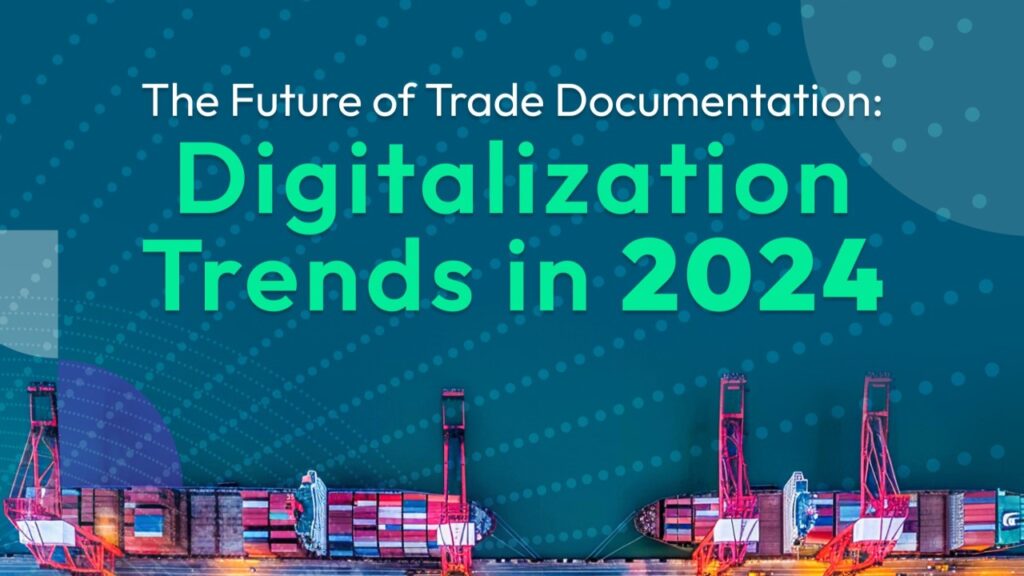The Future of Trade Documentation: Digitalization Trends in 2024
The shipping industry is experiencing an exciting transformation, and you’re in the middle of it. As we look ahead to 2024, digitalization trends in shipping are set to revolutionize trade documentation management.
Gone are the days of juggling multiple systems, dealing with paper trails, and worrying about outdated versions of critical documents. Instead, a wave of new technologies is making trade more efficient, secure, and accessible.
This blog post dives into the key digitalization trends that are reshaping the future of trade documentation.
The Rise of Electronic Bills of Lading (eBLs)
One of the most significant digitalization trends in shipping is the widespread adoption of electronic Bills of Lading (eBLs). If we’ve been stuck with paper-based bills, we know how cumbersome they can be. With eBLs, we can say goodbye to those paper stacks. These digital documents streamline the entire process, reducing costs and errors while speeding up transactions.
According to a recent McKinsey report, the adoption of eBLs could save the shipping industry up to $6.5 billion annually and unlock $40 billion in global trade by 2030. eBLs are not just a convenience—they’re becoming a necessity as the industry moves towards more sustainable and efficient practices.
The Digital Container Shipping Association (DCSA) has been instrumental in pushing for standardized eBLs, and we’re seeing more companies embracing this change.
AI and Blockchain: The New Power Duo
When it comes to digitalization trends in shipping, AI and blockchain are the power duo you didn’t know you needed. With AI, your trade documents are automatically generated, checked for errors, tracked, and verified for compliance.
But it doesn’t stop there.
Blockchain technology adds a layer of security, ensuring that your documents are tamper-proof and easily traceable. This means you can trust that the data you’re working with is accurate and up-to-date, helping you make better business decisions.
The best part? This tech isn’t just for big players. Small and medium-sized businesses are also using it to streamline operations and reduce costs.
The Push for Standardization and Harmonization
One of the ongoing challenges in the shipping industry has been the lack of standardized practices across different regions and sectors. But that’s changing fast. The push for standardization is one of the most critical digitalization trends in shipping. Organizations like the International Chamber of Commerce (ICC) and the United Nations are leading efforts to create uniform standards for digital trade documentation.
This harmonization is crucial because it reduces inefficiencies, lowers the risk of errors, and makes it easier for everyone involved to stay on the same page. As these standards become more widely adopted, navigating international trade will become smoother and more predictable.
Sustainability and ESG Reporting
Digitalization trends in shipping aren’t just about making things faster or easier—they’re also about making trade more sustainable. In 2024, expect to see a greater emphasis on Environmental, Social, and Governance (ESG) reporting. This trend is driven by both regulatory requirements and consumer demand for more transparent and responsible business practices.
Digital platforms are now enabling companies to track and report on their emissions data more accurately. This not only helps with regulatory compliance but also enhances a company’s reputation by showing its commitment to sustainability. So, if you’re looking to reduce your carbon footprint, digitalizing your trade documentation is a step in the right direction.
Real-Time Data: The Key to Better Decisions
Another game-changing trend is the growing emphasis on real-time data. Having access to live, actionable data can make all the difference, especially when you need to make decisions on the fly. Whether you’re tracking a shipment, managing inventory, or forecasting demand, real-time data allows you to make decisions with confidence.
Gone are the days of waiting for updates or dealing with outdated information. With digital platforms, you can access the latest data anytime, anywhere. This not only improves efficiency but also gives you a competitive edge in the market.
Your Competitive Edge with WaveBL
WaveBL is at the forefront of these transformative trends, offering innovative solutions that align with the latest developments in electronic trade documentation. Our solution provides:
- Centralized Management: Manage all your trade documents in one place, streamlining operations and improving efficiency.
- Real-Time Visibility: Track and manage your entire supply chain with live data, making informed business decisions quickly.
- Enhanced Security: Blockchain technology keeps your documents secure and tamper-proof, reducing the risk of fraud.
- Automated Documentation: Save time with automatic generation of key documents like shipping instructions, reducing errors and ensuring compliance.
- Sustainability: Go paperless to support ESG goals and reduce your carbon footprint.
Customer Testimonials: Real Impact, Real Benefits
Our customers have experienced significant improvements in efficiency and cost savings by adopting WaveBL’s electronic trade documentation solutions:
- RS Logistics: “Working on a singular platform has increased our efficiency and workflow effectiveness by 70%.”
- KPM: “Using WaveBL saved 2.5 hours of work per BL. Now, eBLs arrive 5 days before cargo, a significant improvement from the previous 3-day lag time.”
- Pegasus: “We no longer need to deal with delivery delays due to weather, traffic, geopolitical challenges, COVID, and other concerns.”
By embracing these trends and leveraging WaveBL’s solutions, businesses can stay ahead of the curve and achieve unparalleled efficiency and competitiveness in their trade operations.
Join the Electronic Trade Document Revolution: Work Smarter with WaveBL
As we move into 2024, these digitalization trends in shipping are set to transform the industry. From the rise of eBLs to the integration of AI and blockchain, the future of trade documentation looks brighter—and more digital—than ever.
But the journey doesn’t end here. Staying ahead of the curve means embracing these changes and leveraging the latest technologies to streamline your operations, reduce costs, and drive growth. So, why not start today?
With solutions like WaveBL’s next-gen solution, you can take control of your trade documentation and step confidently into the future.



